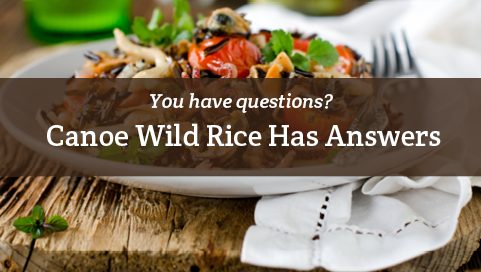
Wild rice is one of those amazingly versatile ingredients, yet many people are unfamiliar with this grain. Some have concerns about how to store and prepare wild rice, while others are unsure of which recipes to try. Some of the most frequently asked questions about this tasty rice are answered below.
How do I cook wild rice?
Preparing wild rice is not as tough as you might think. 1 cup of wild rice will yield about 3-4 cups of cooked rice. Use 3-4 cups of boiling water for every cup of uncooked rice in a pot, and err on the side of extra since you can drain any excess liquid. After adding the rice to the pot, return to a boil and stir. Cover and simmer for 30-45 minutes (less time for chewier rice, longer for fluffier texture). The kernels will start to split open when they’re done.
Try it out a few times to determine your desired water content. Alternatively, if that sounds too daunting, or you don’t have enough time, we’ve made life easy for you with Canoe’s ready-to-go wild rice!
How long can I store wild rice?
Generally speaking, indefinitely! Uncooked wild rice’s shelf life is forever when kept free of dust and any other contaminants. It can be stored in your pantry, fridge, or freezer. Cooked wild rice, on the other hand, should be refrigerated and consumed within 4-6 days.
Can I freeze wild rice?
Yes! Freezing is a great way to preserve extra cooked wild rice that you won’t be consuming within the week, or using to save prep time on future meals. The shelf life of frozen wild rice is roughly six months. Uncooked wild rice can be stored in the freezer indefinitely to protect against contaminants.
How should I reheat cooked rice?
To reheat rice, simply add 2 tablespoons of water or broth for every cup of rice you’re reheating. Microwave it on high for a minute, or cover and heat for five minutes on the stove top. If heating from frozen, microwave on high for two minutes for every cup of rice.
What is the difference between wild rice and brown rice?
Oddly enough, wild rice and brown rice aren’t even related. Wild rice isn’t a rice at all, it’s a water grass! Wild rice is longer, darker in color, and has a stronger, distinctive flavor. It feels rather firm when cooked. Brown rice, on the other hand, is much lighter and shorter and has a nuttier flavor. It is often a bit chewier.
Nutritionally, wild rice and brown rice are both healthy whole grains. Wild rice has fewer calories and carbs than brown rice, but also less selenium and manganese. It offers more lysine, though, and a bit more protein. For more details on the differences, read more here.
How should I eat wild rice?
There are countless ways to enjoy wild rice. You can find some fantastic recipes on the recipe section of our website, and follow our blog for even more recipes and suggestions!
